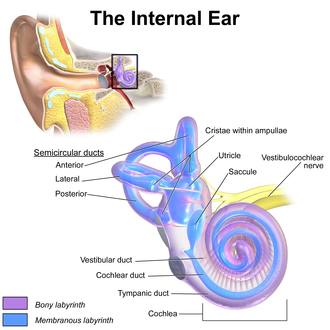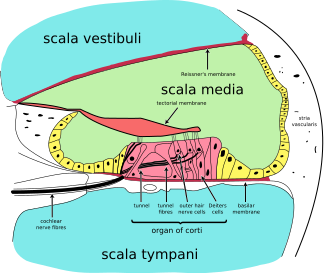Inner ear




Inner ear is the innermost part of the ear, a complex structure responsible for sound detection and balance. It is found in all vertebrates, with substantial variations in form and function. The inner ear houses the vestibular system, which contributes to our sense of balance and spatial orientation, and the cochlea, which detects sound.
Anatomy[edit]
The inner ear is composed of two main parts: the bony labyrinth and the membranous labyrinth. The bony labyrinth is a system of passages making up two main functional parts: the cochlea and the vestibular system. The cochlea is involved in hearing, while the vestibular system helps with balance.
Cochlea[edit]
The cochlea is a spiral-shaped cavity in the bony labyrinth, making it the main organ of hearing. It is divided into three fluid-filled spaces: the scala vestibuli, the scala media, and the scala tympani. The organ of Corti, located within the scala media, is the sensory receptor organ for hearing.
Vestibular system[edit]
The vestibular system is the region of the inner ear where the semicircular canals converge, close to the cochlea. The vestibular system is responsible for providing our brain with information about our body's motion and orientation in space.
Function[edit]
The inner ear performs two major functions: hearing and balance. The cochlea converts sound pressure patterns from the outer ear into electro-chemical impulses which are passed on to the brain via the auditory nerve. The vestibular system is responsible for maintaining our body's balance.
Disorders[edit]
There are several disorders that can affect the inner ear, including Meniere's disease, vestibular neuritis, and labyrinthitis. These conditions can lead to symptoms such as dizziness, tinnitus, and hearing loss.
Additional images[edit]
-
Inner ear
-
Inner ear
-
Inner ear
-
Inner ear
-
Inner ear
-
Inner ear
-
Inner ear
See also[edit]
Ad. Transform your life with W8MD's Budget GLP-1 injections from $75


W8MD offers a medical weight loss program to lose weight in Philadelphia. Our physician-supervised medical weight loss provides:
- Weight loss injections in NYC (generic and brand names):
- Zepbound / Mounjaro, Wegovy / Ozempic, Saxenda
- Most insurances accepted or discounted self-pay rates. We will obtain insurance prior authorizations if needed.
- Generic GLP1 weight loss injections from $75 for the starting dose.
- Also offer prescription weight loss medications including Phentermine, Qsymia, Diethylpropion, Contrave etc.
NYC weight loss doctor appointmentsNYC weight loss doctor appointments
Start your NYC weight loss journey today at our NYC medical weight loss and Philadelphia medical weight loss clinics.
- Call 718-946-5500 to lose weight in NYC or for medical weight loss in Philadelphia 215-676-2334.
- Tags:NYC medical weight loss, Philadelphia lose weight Zepbound NYC, Budget GLP1 weight loss injections, Wegovy Philadelphia, Wegovy NYC, Philadelphia medical weight loss, Brookly weight loss and Wegovy NYC
|
WikiMD's Wellness Encyclopedia |
| Let Food Be Thy Medicine Medicine Thy Food - Hippocrates |
Medical Disclaimer: WikiMD is not a substitute for professional medical advice. The information on WikiMD is provided as an information resource only, may be incorrect, outdated or misleading, and is not to be used or relied on for any diagnostic or treatment purposes. Please consult your health care provider before making any healthcare decisions or for guidance about a specific medical condition. WikiMD expressly disclaims responsibility, and shall have no liability, for any damages, loss, injury, or liability whatsoever suffered as a result of your reliance on the information contained in this site. By visiting this site you agree to the foregoing terms and conditions, which may from time to time be changed or supplemented by WikiMD. If you do not agree to the foregoing terms and conditions, you should not enter or use this site. See full disclaimer.
Credits:Most images are courtesy of Wikimedia commons, and templates, categories Wikipedia, licensed under CC BY SA or similar.
Translate this page: - East Asian
中文,
日本,
한국어,
South Asian
हिन्दी,
தமிழ்,
తెలుగు,
Urdu,
ಕನ್ನಡ,
Southeast Asian
Indonesian,
Vietnamese,
Thai,
မြန်မာဘာသာ,
বাংলা
European
español,
Deutsch,
français,
Greek,
português do Brasil,
polski,
română,
русский,
Nederlands,
norsk,
svenska,
suomi,
Italian
Middle Eastern & African
عربى,
Turkish,
Persian,
Hebrew,
Afrikaans,
isiZulu,
Kiswahili,
Other
Bulgarian,
Hungarian,
Czech,
Swedish,
മലയാളം,
मराठी,
ਪੰਜਾਬੀ,
ગુજરાતી,
Portuguese,
Ukrainian










